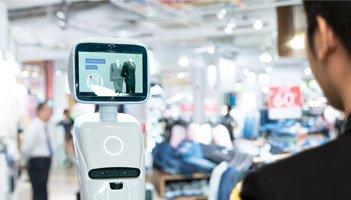Editor’s note: This article on machine learning and AI appeared originally in Huffington Post UK
In this digital age, we are starting to see great practical ways in which artificial intelligence (AI) and machine learning can shake up the status quo. Take the recently launched ‘robot lawyer’ DoNotPay for example – an AI powered chatbot that gives free legal and immigration advice. Then there is the marketers’ mission to create a utopian, near-perfect experience for customers, with the likes of the O2 announcing that AI is set to handle its customer services from 2017 with a voice recognition system called Aura.
AI, machine learning and predictive intelligence are terms that are frequently thrown around in the marketing space, and we’ve known for a while now how these emerging technologies are going to transform businesses and the customer journey, but how will the everyday man or woman on the street feel about the experience in reality? There is still a level of apprehension from customers about talking to an automated so-called robot instead of real people, but in fact, AI and machine learning can help humanize the customer experience by making it more personal for each user.
Machine learning: predictive and proactive user experience
Studies have shown that 78% of customers start the buying process with a web search, while 50% of us turn to social media to see what others have reviewed, before we even think of clicking that buy button. Wouldn’t it be great if businesses took this a step further, and right at the time when you were looking up attractions in a city you’re going to visit, a hotel decided to offer you a discount, or for instance, a restaurant tempted you with a dinner voucher just as you were about to book a table for a date? Machine learning is starting to make this happen and it’s the reason behind the success of services like Netflix, which make life easier for customers by tailoring to their needs.
As customers, we get tired of businesses and brands engaging with us only if they want something from us, and when you purchase that thing, you get radio silence. Ultimately as human beings we don’t like stereotypes, and the tools that marketers have today often treat customers as stereotypes. With more channels, social platforms and websites than ever before, our expectations as customers have shifted; we don’t want businesses to create persona and tracks, we want them to personalize their approach to us, make it unique, and be there for us to deliver us helpful information even after we purchase and become a customer.
Machine learning case study
The humble beginnings of Google Maps is a good example of how a product has evolved by using AI elements to benefit the customer experience. It started with a simple cloud based map and, after having incorporated data such as streets, traffic signals and finally, real-time traffic updates, provides a platform that travelers now almost can’t live without. Automated navigation software, such as Google Maps and Waze, have essentially become “co-pilots” for many drivers – collecting real-time information, understanding where drivers are at in their journey and continuously learning their frequent destinations, commuting hours, and preferred routes. And ultimately, applying all of this in an personalized and actionable way — to essentially make sure we don’t end up in the middle of a lake when driving from A to B.
As Waze, Google Maps, and even Act-On’s plan for Adaptive Journeys illustrate, there is scope for applying AI intelligently into customer’s lives online, to create a better experience for them. So, when it comes to your own shopping experience and customer journey, instead of being forced down a predetermined buying path, AI can turn all the collected information into a better experience for the end user, whilst continuously learning and adapting to individuals. For example, I have two young kids, and tend to do a lot of my research between 10 and 11 o’clock at night, including combing through my e-mails. This would be the best time for businesses to send me a message, but it could be a terrible time to contact a person who regularly has an early night. By creating customer journeys that can respond and change to the unique needs of an individual, marketers can have tools that act as their “co-pilots” to ensure the best message goes out to recipients at the most optimal time through their preferred channels.
Conclusion
In conclusion, AI ‘robots’ need not be feared by customers, as machine learning can be used to enhance their experience when they engage with companies. Automated navigation software permanently changed how we map out our journeys today. Similarly, automated marketing software with Adaptive Journeys will permanently change customer journeys of the future — creating more authentic and better customer experiences.
